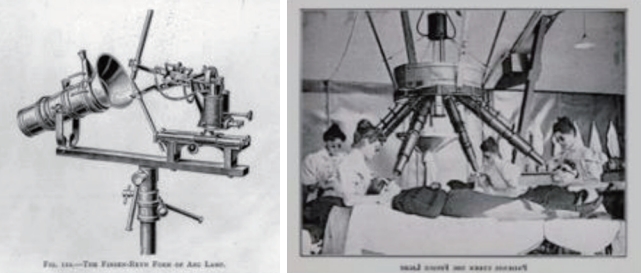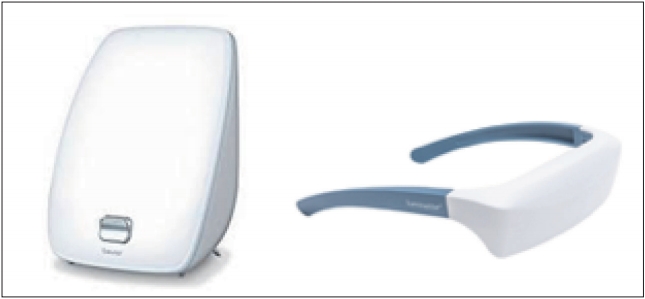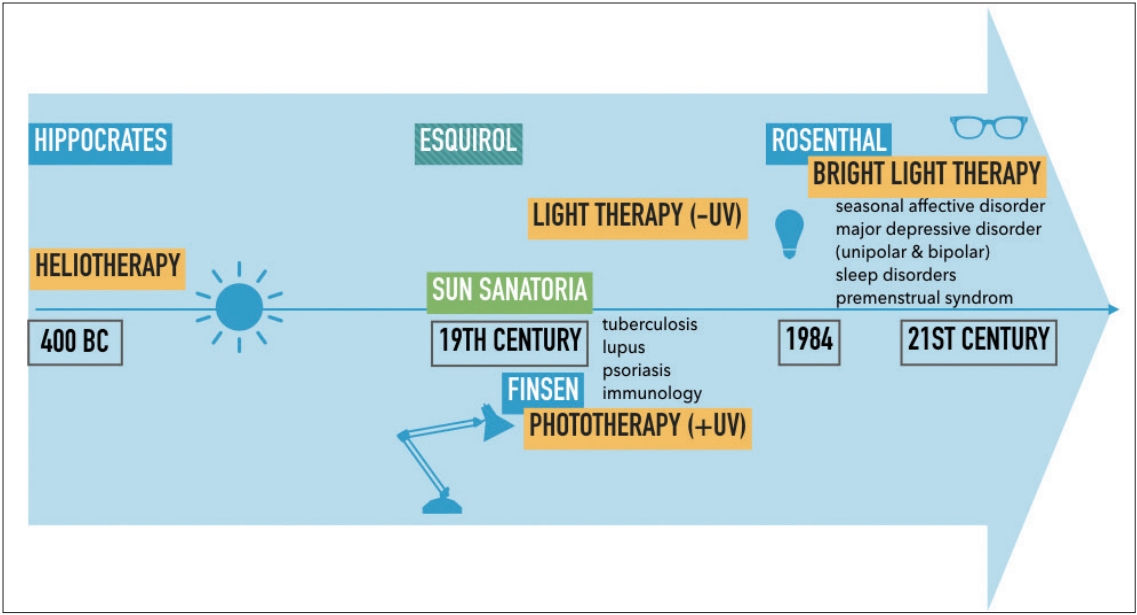1. Rosenthal NE, Sack DA, Gillin JC, Lewy AJ, Goodwin FK, Davenport Y, et al. Seasonal affective disorder. A description of the syndrome and preliminary findings with light therapy. Arch Gen Psychiatry 1984;41:72–80.


2. Geoffroy PA, Schroder CM, Bourgin P. Light treatment in depression: an antique treatment with new insights. Sleep Med Rev 2018;40:218–219.


3. Geoffroy PA. Clock genes and light signaling alterations in bipolar disorder: when the biological clock is off. Biol Psychiatry 2018;84:775–777.


5. Jarrett P, Scragg R. A short history of phototherapy, vitamin D and skin disease. Photochem Photobiol Sci 2017;16:283–290.


6. Angst J, Marneros A. Bipolarity from ancient to modern times: conception, birth and rebirth. J Affect Disord 2001;67:3–19.


7. Eagles JM. Seasonal affective disorder. Br J Psychiatry 2003;182:174–176.


8. Ellis WC. Traité de l’aliénation mentale, ou De la nature, des causes, des symptômes et du traitement de la folie: comprenant des observations sur les établissements d’aliénés. Available at:
https://gallica.bnf.fr/ark:/12148/bpt6k76588g. Accessed August 8, 2018.
9. Esquirol JED. Des établissements d’aliénés en France: Mémoire. Paris, Imprimerie de Madame Huzard. 1819.
10. Poirier J, Clarac F, Barbara JG, Broussolle E. Figures and Institutions of the neurological sciences in Paris from 1800 to 1950. Part IV: psychiatry and psychology. Rev Neurol (Paris) 2012;168:389–402.


12. Grzybowski A, Sak J, Pawlikowski J. A brief report on the history of phototherapy. Clin Dermatol 2016;34:532–537.


13. Grzybowski A, Pietrzak K. From patient to discoverer--Niels Ryberg Finsen (1860–1904) --the founder of phototherapy in dermatology. Clin Dermatol 2012;30:451–455.


14. Maruani J, Anderson G, Etain B, Lejoyeux M, Bellivier F, Geoffroy PA. The neurobiology of adaptation to seasons: relevance and correlations in bipolar disorders. Chronobiol Int 2018;35:1335–1353.


15. Menculini G, Verdolini N, Murru A, Pacchiarotti I, Volpe U, Cervino A, et al. Depressive mood and circadian rhythms disturbances as outcomes of seasonal affective disorder treatment: a systematic review. J Affect Disord 2018;241:608–626.


16. Geoffroy PA, Fovet T, Micoulaud-Franchi JA, Boudebesse C, Thomas P, Etain B, et al. [Bright light therapy in seasonal bipolar depressions]. Encephale 2015;41:527–533.


17. Al-Karawi D, Jubair L. Bright light therapy for nonseasonal depression: meta-analysis of clinical trials. J Affect Disord 2016;198:64–71.


18. Tseng PT, Chen YW, Tu KY, Chung W, Wang HY, Wu CK, et al. Light therapy in the treatment of patients with bipolar depression: a meta-analytic study. Eur Neuropsychopharmacol 2016;26:1037–1047.


19. Kupeli NY, Bulut NS, Bulut GC, Kurt E, Kora K. Efficacy of bright light therapy in bipolar depression. Psychiatry Res 2018;260:432–438.


20. Zhou TH, Dang WM, Ma YT, Hu CQ, Wang N, Zhang GY, et al. Clinical efficacy, onset time and safety of bright light therapy in acute bipolar depression as an adjunctive therapy: a randomized controlled trial. J Affect Disord 2018;227:90–96.


21. Wirz-Justice A, Benedetti F, Terman M. Chronotherapeutics for affective disorders: a clinician’s manual for light and wake therapy (2nd ed). Basel: S. Karger AG, 2013.
22. Kripke DF, Tuunainen A, Endo T. Benefits of light treatment for depression. Am J Psychiatry 2006;163:162–163.

24. Loving RT, Kripke DF, Shuchter SR. Bright light augments antidepressant effects of medication and wake therapy. Depress Anxiety 2002;16:1–3.


25. Penders TM, Stanciu CN, Schoemann AM, Ninan PT, Bloch R, Saeed SA. Bright light therapy as augmentation of pharmacotherapy for treatment of depression: a systematic review and meta-analysis. Prim Care Companion CNS Disord 2016;Oct 20 [Epub]. Available at:
https://doi.org.10.4088/PCC.15r01906.

26. Lam RW, Levitt AJ, Levitan RD, Michalak EE, Cheung AH, Morehouse R, et al. Efficacy of bright light treatment, fluoxetine, and the combination in patients with nonseasonal major depressive disorder: a randomized clinical trial. JAMA Psychiatry 2016;73:56–63.


27. Sit D, Wisner KL, Hanusa BH, Stull S, Terman M. Light therapy for bipolar disorder: a case series in women. Bipolar Disord 2007;9:918–927.


32. Hubbard J, Ruppert E, Gropp CM, Bourgin P. Non-circadian direct effects of light on sleep and alertness: lessons from transgenic mouse models. Sleep Med Rev 2013;17:445–452.


33. Stephenson KM, Schroder CM, Bertschy G, Bourgin P. Complex interaction of circadian and non-circadian effects of light on mood: shedding new light on an old story. Sleep Med Rev 2012;16:445–454.


34. Bauer MS. Summertime bright-light treatment of bipolar major depressive episodes. Biol Psychiatry 1993;33:663–665.


35. Lam RW, Levitt AJ, Levitan RD, Enns MW, Morehouse R, Michalak EE, et al. The Can-SAD study: a randomized controlled trial of the effectiveness of light therapy and fluoxetine in patients with winter seasonal affective disorder. Am J Psychiatry 2006;163:805–812.


36. Benedetti F. Rate of switch from bipolar depression into mania after morning light therapy: a historical review. Psychiatry Res 2018;261:351–356.


37. Benedetti F, Avery DH, Bauer M, Bunney WE, Çaliyurt O, Camardese G, et al. Evidence for the efficacy of bright light therapy for bipolar depression. Am J Psychiatry 2018;175:905–906.


38. Sit DK, Terman M, Wisner KL. Light therapy and risk of hypomania, mania, or mixed state emergence: response to Benedetti et al. Am J Psychiatry 2018;175:906.

39. Sit DK, McGowan J, Wiltrout C, Diler RS, Dills JJ, Luther J, et al. Adjunctive bright light therapy for bipolar depression: a randomized double-blind placebo-controlled trial. Am J Psychiatry 2018;175:131–139.

















